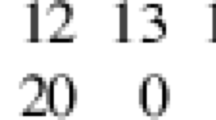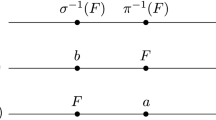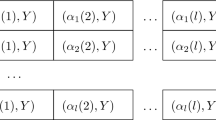Abstract
Let M(n, d) be the maximum size of a permutation array on n symbols with pairwise Hamming distance at least d. We use various combinatorial, algebraic, and computational methods to improve lower bounds for M(n, d). We compute the Hamming distances of affine semilinear groups and projective semilinear groups, and unions of cosets of AGL(1, q) and PGL(2, q) with Frobenius maps to obtain new, improved lower bounds for M(n, d). We give new randomized algorithms. We give better lower bounds for M(n, d) also using new theorems concerning the contraction operation. For example, we prove a quadratic lower bound for \(M(n,n-2)\) for all \(n\equiv 2 \pmod 3\) such that \(n+1\) is a prime power.




Similar content being viewed by others
Notes
A factor of k is proper if it is smaller than k.
Since f and g are bijections, they correspond to permutations.
Recall that, for a permutation group G on a set X, the stabilizer of an element \(x\in X\) is the set of permutations \(\{g\in G : g(x)=x\}\).
Note that \(N_{GV}(16,9)=97,579\).
References
Bereg S., Morales L., Sudborough I.H.: Parallel and sequential partition and extension techniques. Manuscript, The University of Texas Dallas (2016).
Bereg S., Morales L., Sudborough I.H.: Extending permutation arrays: improving MOLS bounds. Des. Codes Cryptogr. 83(3), 661–683 (2017).
Blake I.F., Cohen G.D., Deza M.: Coding with permutations. Inform. Control 43(1), 1–19 (1979).
Cameron P.: Permutation Groups. London Mathematical Society Student TextsCambridge University Press, Cambridge (1999).
Chu W., Colbourn C.J., Dukes P.: Constructions for permutation codes in powerline communications. Des. Codes Cryptogr. 32(1–3), 51–64 (2004).
Colbourn C.J., Kløve T., Ling A.C.H.: Permutation arrays for powerline communication and mutually orthogonal latin squares. IEEE Trans. Inform. Theory 50(6), 1289–1291 (2004).
Conway J.H., Curtis R.T., Norton S.P., Parker R.A., Wilson R.A.: Atlas of Finite Groups: Maximal Subgroups and Ordinary Characters for Simple Groups. Clarendon Press, Oxford (1985).
Dixon J., Mortimer B.: Permutation Groups. Springer, New York (1996).
Dummit D.S., Foote R.M.: Abstract Algebra, 2nd edn. Wiley, New York (1999).
Frankl P., Deza M.: On the maximum number of permutations with given maximal or minimal distance. J. Comb. Theory Ser. A 22(3), 352–360 (1977).
Gao F., Yang Y., Ge G.: An improvement on the Gilbert-Varshamov bound for permutation codes. IEEE Trans. Inform. Theory 59(5), 3059–3063 (2013).
Herstein I.N.: Topics in Algebra, 2nd edn. Wiley, New York (1975).
Huczynska S.: Powerline communication and the 36 officers problem. Philos. Trans. R. Soc. Lond. A 364(1849), 3199–3214 (2006).
Janiszczak I., Lempken W., Östergård P.R.J., Staszewski R.: Permutation codes invariant under isometries. Des. Codes Cryptogr. 75(3), 497–507 (2015).
Janiszczak I., Staszewski R.: An improved bound for permutation arrays of length 10. Technical Report 4, Institute for Experimental Mathematics, University Duisburg-Essen (2008).
Lidl R., Niederreiter H.: Finite Fields, 2nd edn. Cambridge University Press, Cambridge (1997).
MacWilliams F.J., Sloane N.J.A.: The Theory of Error-Correcting Codes. North-Holland/Elsevier, Amsterdam (1977).
Passman D.: Sharp transitivity. In: Permutation Groups. Benjamin, Inc., New York (1968).
Pavlidou N., Vinck A.H., Yazdani J., Honary B.: Power lines communications: state of the art and future trends. IEEE Commun. Mag. 34–40 (2003).
Pless V.S., H W.C. (eds.): Handbook of Coding Theory. North-Holland/Elsevier, Amsterdam (1998).
Smith D.H., Montemanni R.: A new table of permutation codes. Des. Codes Cryptogr. 63(2), 241–253 (2012).
Table of cosets. http://www.utdallas.edu/~sxb027100/cosets.
Yang L., Chen K., Yuan L.: New constructions of permutation arrays. arXiv:abs/0801.3987 (2008).
Yang L., Chen K., Yuan L.: New lower bounds on sizes of permutation arrays. arXiv:abs/0801.3986 (2008).
Author information
Authors and Affiliations
Corresponding author
Additional information
Communicated by C. J. Colbourn.
Appendix
Appendix
Finite Fields Let \(n=p^k\) be a prime power. There is a field \(\mathbb {F}_n\) with n elements, unique up to isomorphism. We consider groups over the field \(\mathbb {F}_n\).
Groups The group AGL(1, n) consists of the affine linear transformations
where the group operation is function composition. This group is sharply \(2-\)transitive and has \(n(n-1)\) elements.
Denote the symbols of \(Z_{n+1}\) by \(0,1,2,\dots ,n-1,\infty \). The permutations of PGL(2, n) are \(g:x\rightarrow \frac{ax+b}{cx+d}\) on \(Z_{n+1}\) such that \(a,b,c,d\in GF(n), ad\ne bc, g(\infty )=a/c,g(-d/c)=\infty \) if \(c\ne 0\) and \(g(\infty )=\infty \) if \(c=0\). Then \(|PGL(2,n)|=(n+1)n(n-1)\).
Recall that \(n=p^k\). The group of affine semilinear polynomials \(A\Gamma L(1,n)\) arises as a semidirect product of AGL(1, n) with a cyclic group of order k. It is generated by iteratively composing the Frobenius automorphism \(x^p\) with the elements of AGL(1, n). Equivalently,
This group has \(kn(n-1)\) elements.
The group of projective semilinear polynomials \(P\Gamma L(2,n)\) arises as a semidirect product of PGL(2, n) with a cyclic group of order k generated by the Frobenius automorphism. This group has \(k(n+1)n(n-1)\) elements.
Rights and permissions
About this article
Cite this article
Bereg, S., Levy, A. & Sudborough, I.H. Constructing permutation arrays from groups. Des. Codes Cryptogr. 86, 1095–1111 (2018). https://doi.org/10.1007/s10623-017-0381-1
Received:
Revised:
Accepted:
Published:
Issue Date:
DOI: https://doi.org/10.1007/s10623-017-0381-1




